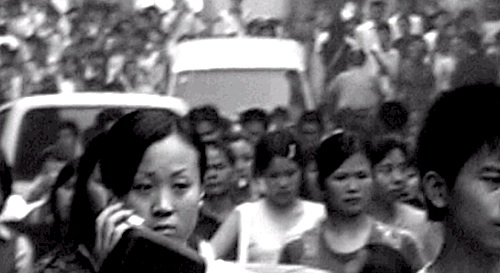By Joe Bendel. It could be called a vanguard village. Now entirely encircled by Guangzhou’s urban sprawl, San Yuan Li was once a hotbed of resistance during the Opium Wars. However, drug abuse and other social pathologies have recently become comparatively more advanced there. Yet, new and old China persist, side-by-side each other. A team of artists document the neighborhood’s daily facts of life in Ou Ning & Cao Fei’s San Yuan Li, which screens with Huang Weikai’s Disorder as part of MoMA’s Chinese Realities/Documentary Visions film series.
Industrialization has left a questionable mark on the village. In rapid succession, the audience sees the cramped narrow alleys, dingy sweatshops, haunted looking factories, and the hardscrabble laborers toiling along the river. These are literal “fly-over People,” living beneath the constant approach of airliners. In contrast, viewers also encounter the modern consumerist class (often at booty level), as well as the young color guards and traditional performers representing the ideals of previous eras.
With its frenetically quick cuts and driving soundtrack, San Yuan Li is far more accessible than the term “experimental documentary” would suggest. Although shot in a very stylish black-and-white, the film is sort of like a National Geographic photo spread with a postmodern sensibility and an elevated social awareness. The net effect is often rather hypnotic. While not quite as pointed as Disorder, they are quite a compatible pairing, collectively clocking in at about one and three-quarter hours.

Still, there are plenty of telling images throughout San Yuan Li. Indeed, any appearance of Mao portraiture is now ironic, haunting either the go-go capitalism or mounting class inequities unleashed by the Party. Yet, there is also dignity in the faces of average citizens, particularly the diverse selection of work teams captured late in the film.
Neither documentaries have narrative structures per se, but they both convey a vivid sense of contemporary China. As it happens, both San Yuan Li and Disorder are distributed by the dGenerate films, the invaluable specialists in independent Chinese cinema. Highly recommended for China watchers who want to do exactly that, they screen together this Wednesday (5/22) and the following Monday (5/27) as Chinese Realities continues at MoMA.
LFM GRADE: B
Posted on May 20th, 2013 at 2:19pm.

